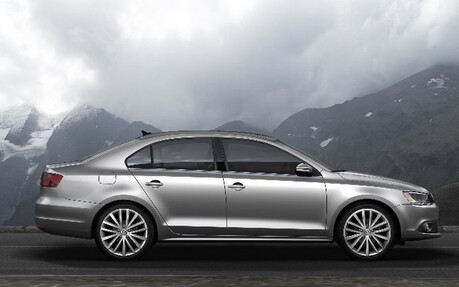The 2011 Volkswagen Jetta: It’s not a Golf anymore!
The new 2011 Jetta was unveiled in New York City’s Times Square in front of an interested crowd and plenty of automobile journalists from all over the world. It was a coming out party of sorts for this model. Until now, the Jetta was derived from the Golf, but after six generations, it will finally able to fly solo. In fact, although it shares several engines with other cars produced by Volkswagen, for the first time it has its very own platform.
This newcomer is launching a new marketing philosophy for North America. Not only was its shape developed according to North American expectations and tastes, but many of these characteristics were based on the recommendations of dealerships and clients.
Generic shape
Although the manufacturer’s press releases talk about its extraordinary contours, it’s actually rather plain. Normally, Volkswagen products set themselves apart one way or another by offering lines that stand out compared to other models in the category. This car won’t lose its looks as it gets older, but it’s rather plain. Despite this small drawback, it’s an elegant car with a front end that was well designed in order to offer a unique presentation and to respond to the safety demands imposed on manufacturers for several years now. There’s a spoiler that’s specially made to reduce injuries in case of a human-car collision and the overhanging hood plays a part in protecting the safety of pedestrians, too.
VW’s design chief, Klaus Bishoff, highlighted the new body’s lack of lines. But the lines that it has play an important, in particular the one that begins on the hood, continues to the beltline and ends at the back. Basically, this car is very subtle and you’ll get to like it more and more over the months and years.
The passenger compartment is cut from the same cloth, while the materials are surprisingly good quality considering the asking price for the base model. In addition to the quality of the materials, the finish is impeccable on the models that we examined. But before moving on to the details of the layout, it’s important to underline that this car is impressively spacious. Tall people will feel comfortable in the back seats and the trunk is quite simply huge, with the largest capacity in the category. What’s more, the trunk opening is very generous, which will help you put relatively cumbersome objects inside. And even the more economical version will be equipped with 60/40 rear seat backs that can be lowered. Finally, this newcomer is 74 mm longer, and its wheelbase and track width are larger than with the fifth generation.
The dashboard is simple, as with all other cars produced by Volkswagen. This time, the climate controls are much less complicated and intuitive to operate than those of the Golf, which are in desperate need of change. It’s easy to get a feel for the steering wheel and the two main indicator dials are easy to read with their white numbers on a black background. Overall, everything is where it should be. Of course, our opinion could change when we actually drive the car, since this inspection was done on a stationary car during the first worldwide unveiling.
Four engines please!
While the new Jetta’s platform is brand new, the engineers kept the powertrains already available on the Golf with only one exception: the more economical version’s engine, a 2.0-litre, 115-hp four-cylinder, wasn’t previously offered. The three other powertrains are known entities. There’s the 2.5-litre five-cylinder featuring 170 horsepower and the 2.0-litre, direct injection TSI engine featuring 200 horsepower. It will also be used a little later on the GLI, which will be the most luxurious Jetta offered. Of course, the TDI common rail diesel engine with 140 horses and 236 lbs-ft of torque will be back under the hood of the new Jetta. This engine has won multiple awards since its arrival on the market. Moreover, the Jetta is the only model in the category to offer a diesel engine. A particulate filter and a nitrogen oxides (NOx) storing catalytic converter help the TDI engine respect antipollution norms in effect in Canada and in all the American states.
All the engines come paired factory standard with a manual transmission. It has five speeds on most of the engines while the optional automatic is a six-speed Tiptronic. On the TDI Diesel and TSI models, the optional twin-clutch DSG gearbox is also a six-speed, just like the diesel’s manual transmission.
This time, Volkswagen has given itself the means to become a respectable presence on the market with this compact car. And VW isn’t finished yet, since the Passat’s replacement will arrive over the coming months and should also boost the sales of the European number one on our continent. What’s more, the newcomer will be assembled in Chattanooga, Tennessee. Things seems to have started better than the manufacturer’s last attempt when VW built a plant in Pennsylvania where they made atrocious cars that were completely different from what a Volkswagen is supposed to be. It was a failure. But they swear to us that, this time, they learned their lesson and that Volkswagen is a completely reorganized company that wants to get the part of the North American market that they have coming to them. And succeeding on the North American market will make this manufacturer be able to become the world number one by 2018, which is the date that management has targeted.
